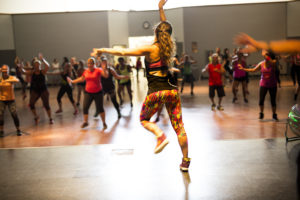Most of us don’t go out for a night dancing in order to squeeze in a good workout. Yet dancing is one of the best exercises for our mental, physical and emotional health. It’s one of those things that immediately after we do it, we ask ourselves why we waited so long. But most of us still don’t consider adding dance to our workout routine. Studies show that getting out of your seat and into a dance flow can help you lose weight, stay flexible, reduce stress, improve your social life, and bring countless more benefits to your life.
Instead of breaking up the day at your desk with a circuit workout or a short jog, consider turning on your favorite song and dancing like no one’s watching.
Since dance is exercise, the physical benefits are similar to that of other cardio workouts. Unlike high impact exercises like running, dancing is gentle on the body. It can also improve flexibility, easing joint pain and alleviating post-exercise soreness. Also unlike other exercises that emphasize repetitive or linear movement, dance allows for the body to move organically and without structure. This not only gives way to creative expression, but can also activate new synapses in the brain and prevent injury.
“Movements that we typically do in our daily life, like walking, taking the stairs, and common workouts like treadmills and cycling, occur in the sagittal plane, but dance works your body from all planes, including lateral and rotational, which turns on and conditions all muscles, meaning no muscle is left behind,” explains Jonathan Tylicki, the director of education for boutique fitness studio AKT, per HealthLine.
Another unique benefit of dance versus other forms of exercise is its ability to improve balance through rhythm and music.
On a mental level, dancing can improve cognitive performance. While it may be true that the best dancers are those that don’t think about it, most of us can agree that dancing requires a high level of presence and brain power. This is required to learn a new style of dance, tune into the rhythm of a new song, or sync up with a dance partner.
A study in the New England Journal of Medicine supports the notion that dancing boosts memory and may prevent the development of dementia. According to the researchers, dancing involves both a mental effort and social interaction, which explains why it was the only one out of 11 different types of physical activity that lowered participants’ risk of dementia.
This may be explained by the fact that aerobic exercise has been shown to reverse volume loss in the hippocampus, the part of the brain responsible for memory retention, per Everyday Health.
Emotionally, dancing can bring about stress relief, improve self-esteem and promote positive emotions. Another study conducted in 2012 by researchers at North Dakota’s Minot State University found that Latin-style dance programs such as Zumba lifted participants’ mood and certain cognitive skills, such as visual recognition and decision-making, per Harvard Medical School.
The benefits of dance are boundless and will affect every individual in a unique way. That said, maybe the most incredible thing about dancing is that it is the great equalizer. Anyone with mobility in their body, even if limited, can participate. This makes it a great social activity, and a fun way to connect with others.
With all of the different forms of dance that exist, such as ballet, hip hop, tap dancing, swing dancing, salsa, belly dancing, pole dancing, and more, there’s bound to be something for everyone.

